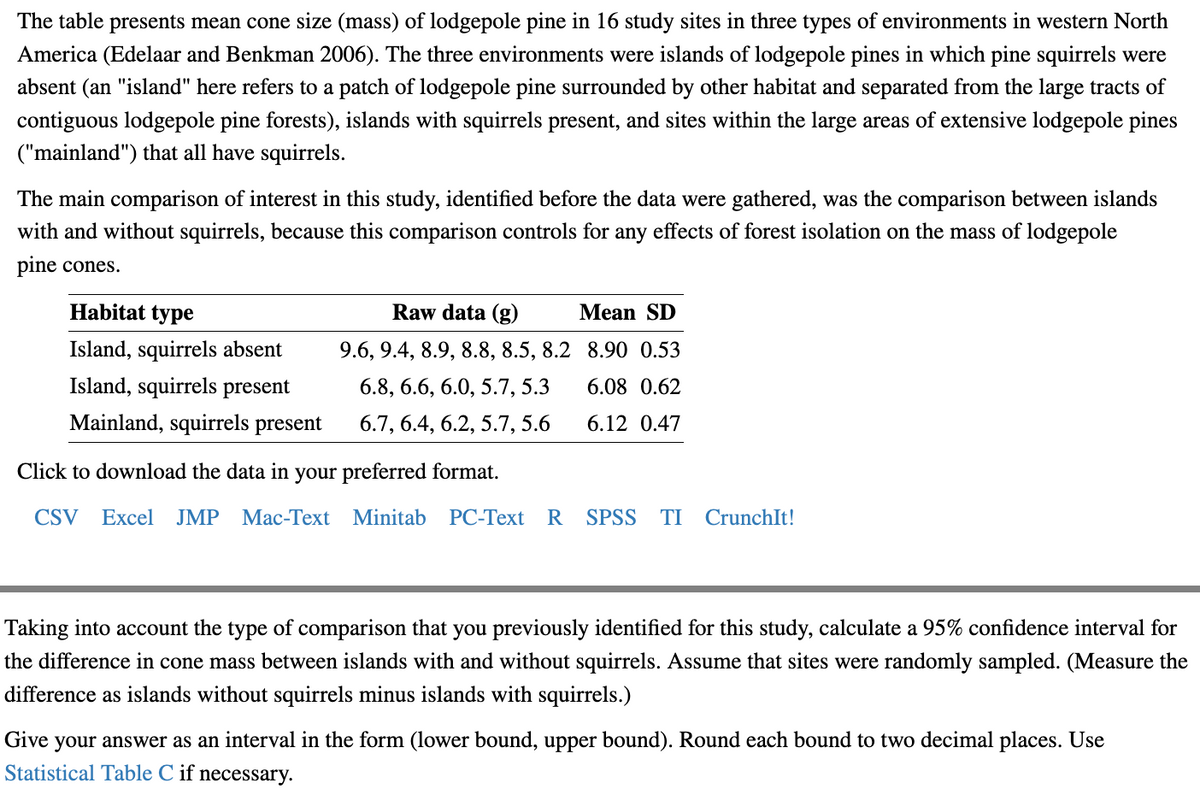The table presents mean cone size (mass) of lodgepole pine in 16 study sites in three types of environments in western North America (Edelaar and Benkman 2006). The three environments were islands of lodgepole pines in which pine squirrels were absent (an "island" here refers to a patch of lodgepole pine surrounded by other habitat and separated from the large tracts of contiguous lodgepole pine forests), islands with squirrels present, and sites within the large areas of extensive lodgepole pines ("mainland") that all have squirrels. The main comparison of interest in this study, identified before the data were gathered, was the comparison between islands with and without squirrels, because this comparison controls for any effects of forest isolation on the mass of lodgepole pine cones. Habitat type Island, squirrels absent Island, squirrels present Mainland, squirrels present Raw data (g) 9.6, 9.4, 8.9, 8.8, 8.5, 8.2 6.8, 6.6, 6.0, 5.7, 5.3 6.7, 6.4, 6.2, 5.7, 5.6 Mean SD 8.90 0.53 6.08 0.62 6.12 0.47 Click to download the data in your preferred format. CSV Excel JMP Mac-Text Minitab PC-Text R SPSS TI CrunchIt! Taking into account the type of comparison that you previously identified for this study, calculate a 95% confidence interval for the difference in cone mass between islands with and without squirrels. Assume that sites were randomly sampled. (Measure the difference as islands without squirrels minus islands with squirrels.) Give your answer as an interval in the form (lower bound, upper bound). Round each bound to two decimal places. Use Statistical Table C if necessary.
The table presents mean cone size (mass) of lodgepole pine in 16 study sites in three types of environments in western North America (Edelaar and Benkman 2006). The three environments were islands of lodgepole pines in which pine squirrels were absent (an "island" here refers to a patch of lodgepole pine surrounded by other habitat and separated from the large tracts of contiguous lodgepole pine forests), islands with squirrels present, and sites within the large areas of extensive lodgepole pines ("mainland") that all have squirrels. The main comparison of interest in this study, identified before the data were gathered, was the comparison between islands with and without squirrels, because this comparison controls for any effects of forest isolation on the mass of lodgepole pine cones. Habitat type Island, squirrels absent Island, squirrels present Mainland, squirrels present Raw data (g) 9.6, 9.4, 8.9, 8.8, 8.5, 8.2 6.8, 6.6, 6.0, 5.7, 5.3 6.7, 6.4, 6.2, 5.7, 5.6 Mean SD 8.90 0.53 6.08 0.62 6.12 0.47 Click to download the data in your preferred format. CSV Excel JMP Mac-Text Minitab PC-Text R SPSS TI CrunchIt! Taking into account the type of comparison that you previously identified for this study, calculate a 95% confidence interval for the difference in cone mass between islands with and without squirrels. Assume that sites were randomly sampled. (Measure the difference as islands without squirrels minus islands with squirrels.) Give your answer as an interval in the form (lower bound, upper bound). Round each bound to two decimal places. Use Statistical Table C if necessary.
Glencoe Algebra 1, Student Edition, 9780079039897, 0079039898, 2018
18th Edition
ISBN:9780079039897
Author:Carter
Publisher:Carter
Chapter10: Statistics
Section10.3: Measures Of Spread
Problem 1GP
Related questions
Question
please answer 95% confidence interval - answer is NOT 2.04,3.60!!!!
this is a planned comparison study!

Transcribed Image Text:The table presents mean cone size (mass) of lodgepole pine in 16 study sites in three types of environments in western North
America (Edelaar and Benkman 2006). The three environments were islands of lodgepole pines in which pine squirrels were
absent (an "island" here refers to a patch of lodgepole pine surrounded by other habitat and separated from the large tracts of
contiguous lodgepole pine forests), islands with squirrels present, and sites within the large areas of extensive lodgepole pines
("mainland") that all have squirrels.
The main comparison of interest in this study, identified before the data were gathered, was the comparison between islands
with and without squirrels, because this comparison controls for any effects of forest isolation on the mass of lodgepole
pine cones.
Habitat type
Island, squirrels absent
Island, squirrels present
Mainland, squirrels present
Click to download the data in your preferred format.
CSV Excel JMP Mac-Text Minitab PC-Text R SPSS TI CrunchIt!
Raw data (g)
9.6, 9.4, 8.9, 8.8, 8.5, 8.2
6.8, 6.6, 6.0, 5.7, 5.3
6.7, 6.4, 6.2, 5.7, 5.6
Mean SD
8.90 0.53
6.08 0.62
6.12 0.47
Taking into account the type of comparison that you previously identified for this study, calculate a 95% confidence interval for
the difference in cone mass between islands with and without squirrels. Assume that sites were randomly sampled. (Measure the
difference as islands without squirrels minus islands with squirrels.)
Give
your answer as an interval in the form (lower bound, upper bound). Round each bound to two decimal places. Use
Statistical Table C if necessary.
Expert Solution
This question has been solved!
Explore an expertly crafted, step-by-step solution for a thorough understanding of key concepts.
This is a popular solution!
Trending now
This is a popular solution!
Step by step
Solved in 4 steps with 3 images

Recommended textbooks for you

Glencoe Algebra 1, Student Edition, 9780079039897…
Algebra
ISBN:
9780079039897
Author:
Carter
Publisher:
McGraw Hill

Glencoe Algebra 1, Student Edition, 9780079039897…
Algebra
ISBN:
9780079039897
Author:
Carter
Publisher:
McGraw Hill